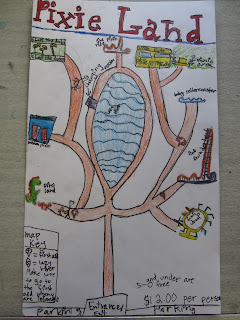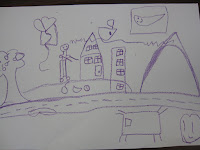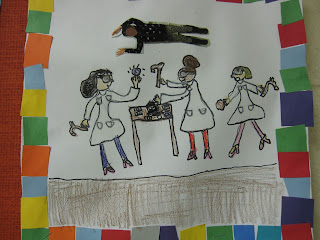
Wednesday, March 30, 2016
Watercolor Resist
Kindergarten students created a watercolor resist with white crayons and watercolor paint. They also created an umbrella with crayons. They glued in their picture to make it look like they were holding their umbrella.


Bubble-Wrap printing and an octopus!
Friday, March 25, 2016
Theme Park Maps
Fourth grade students discussed technical drawing as a possible art career. Students learned that artists help design both theme parks and the maps of theme parks. Students created their own theme parks that included a parking lot, an entrance, bathrooms, a food court and at least 6 attractions.They colored their theme parks with colored pencil.




Pop Art Self-Portraits
Fifth Grade students looked at
artwork by Andy Warhol. Warhol is famous for creating pop-art images. Pop Art
is short for popular art which means using everyday pictures or images such as
photos of celebrities or mundane things like soup cans, and turning them into
fancy museum art. Much of this type of artwork was and is used in advertising.
Students altered photos of themselves on a website called www.phixr.com, then traced their photo and
finally painted their pop-art portraits. They could only use two colors to
paint their portrait in this graphic style. They had to choose complimentary
colors (colors across each other on the color wheel) or analogous colors
(colors next to each other on the color wheel.)
Los estudiantes de quinto grado
observaron algunas obras de arte de Andy Warhol. Warhol es famoso por crear
imágenes de arte-pop, que significa usar imágenes de la vida diaria, como fotos de celebridades u objetos mundanos como


Mendhi Hands
Second Grade students learned
that art takes many forms around the world. They discovered that people in many
Middle Eastern countries decorate their hands with Mendhi for special occasions
such as weddings as part of a tradition. Mendhi is a paste that is spread on to the hands and is
carefully scratched off with a small wooden tool to create intricate patterns.
They learned that many designs incorporate a paisley pattern. Students then created
their own Mendhi hand designs that include much repetition of lines and shapes as well as a paisley shape.

Cubist Portraits
Third grade students looked at
artwork by Pablo Picasso and read a book about his life. They learned that
Picasso could paint realistically, but chose not to. They learned that Picasso
was the inventor of cubism, and painted many of his artworks with shapes such
as squares and rectangles. Students learned that many people didn’t like his
artwork at first, but now it is some of the most famous artwork in the world.
Students drew a cubist portrait and painted it with tempera paints.
Los
estudiantes de tercer grado miraron obras de arte por Pablo Picasso y leyeron
un libro sobre su vida. Ellos aprendieron que Picasso sabía pintar
realísticamente, pero escogió no hacerlo. Ellos aprendieron que Picasso fue el
inventor del cubismo, y pinto muchas de sus obras con figuras como cuadrados y
rectángulos. Los estudiantes aprendieron que a muchas personas no les gustaron
sus obras al principio, pero ahora son de las obras de arte más famosas del
mundo. Los estudiantes dibujaron un retrato cubista y lo pintaron con tempera.


Kente Cloth Paper Weaving
First Graders learned
about a special fabric called Kente cloth that comes from Ghana , Africa .
Students looked at patterns
common to Kente cloth and learned that this cloth is worn for special
occasions. Using paper weaving
techniques, students created their own version of Kente cloth.

Los estudiantes de primer grado aprendieron sobre tejido especial
llamado tela Kente proveniente de Ghana, África. Los estudiantes observaron los patrones comunes en la tela Kente y
aprendieron que esta tela se usa
Monday, March 14, 2016
"Harold and the Purple Crayon"
Kindergarten students "illustrated" the book Harold and the Purple Crayon by Crockett Johnson by listening to the story (without seeing the pictures) and drawing what Harold drew. Then we read the story again, and looked at the illustrations. Students discovered that even though they had all heard the same story, every drawing was different.


Self-Portraits with a book
Reduction Prints
4th grade students created these reduction prints of the animal of their choice. First they carved an animal into a piece of styrofoam and printed the entire printing block. Then they cut out their animal and printed only that part of the printing block (which is how it gets the name reduction print).


Flower Still Life
Kindergarten students
learned that a still life could be any grouping of small objects that can not
move by themselves. The learned that artists like to put a group of small
objects together to practice drawing or painting them. Students looked at three different still life
paintings by Vincent Van Gogh and then painted their own still life of flowers
in a vase.


Jackson Pollack Styled Paper Mache Letters
5th grade students have been hard at work creating these paper mache letters in the style of Jackson Pollack. They created the armature of the sculpture with paper cups and cardboard. Then they covered the letter's form with paper mache and newspaper. Then the prepared their letter for splatter painting by painting it white and then the following class periods were dedicated to splatter painting.


Fish Prints
Second Grade
students discussed the difference between printing and painting. They learned
that prints can be made multiple times. Students designed their own fish print
by drawing a fish on a piece of styrofoam and then colored it with markers.
Students then printed those fish by spraying a piece of paper with water and
blotting the paper with paper towel. Then they printed their fish on that
paper. Students were able to make multiple prints.
Los estudiantes de Segundo grado discutieron la diferencia entre imprimir y
pintar. Ellos aprendieron que las impresiones se pueden repetir varias veces.
Los estudiantes diseñaron sus propias impresiones dibujando un pez en un pedazo
de unicel y luego lo pintaron con marcadores. Luego los estudiantes imprimieron
esos peces rociando una hoja de papel con agua y secándola con toallas de
papel. Luego imprimieron su pez sobre ese papel. Los estudiantes lograron hacer
varias impresiones.
Kinder Mondrian
Kindergarten students discovered
the work of Piet Mondrian. They learned that he first painted landscapes, but
then decided to break down landscapes into their simplest form: black lines and
primary colors. It was almost like he was painting the “ingredients” for his
landscapes. Students learned to identify the primary colors and made artwork
inspired by Mondrian.
Los
estudiantes de kinder descubrieron las obras de Piet Mondrian. Ellos
aprendieron que al principio el pinto paisajes, pero luego decidió desarmar los
paisajes en sus formas más simples: líneas negras y colores primarios. Fue como
si estuviera pintando los “ingredientes” de sus paisajes. Los estudiantes
aprendieron a identificar los colores primarios y crearon obras de arte
inspiradas por Mondrian.
Tar Beach
Third Grade students read “Tar Beach
Los
estudiantes de tercer grado leyeron “Playa de asfalto” por la famosa artista y
autora afro-americana Faith Ringgold. Los estudiantes discutieron cuales son
sus sueños para el futuro. Luego se dibujaron volando sobre su sueño como una manera de hacerlo realidad, como
Subscribe to:
Comments (Atom)


























